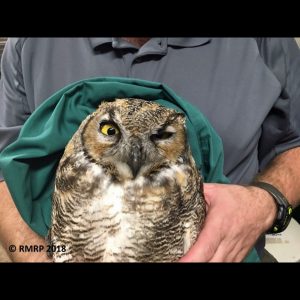
 This story was shared with us by Rocky Mountain Raptor Program in Colorado.
This story was shared with us by Rocky Mountain Raptor Program in Colorado.
On an early November morning, Rocky Mountain Raptor Program’s Rehabilitation Coordinator, Mike Tincher, received a call from a local dairy farm located in Wellington, Colorado. Workers had discovered an injured great horned owl in the paddock with their dairy cows.
Mike rushed to the scene and discovered an extremely subdued great horned owl who was too weak to fly or put up a fight. When he gently bundled it up for transport back to the rehabilitation facility, he discovered that the owl was all feathers and bone.
On admission, the desperate adult owl weighed only 996 grams (just over 2 pounds), a fraction of what a healthy great horned owl should weigh. The cause of the emaciation was clear from old wounds it had sustained to its left eye, mouth and feet. It had clearly been struggling for quite some time to end up in such poor body condition.
Due to its weakened condition, the great horned owl was immediately started on a tube-feeding regimen of EmerAid Intensive Care Carnivore diet. For days, volunteers helping in the care of this beautiful owl reported that it was too weak to struggle or fuss.
After 10 days staff was elated to discover that the owl had perked up and was beginning to develop the angry disposition that great horned owls are usually known for. After that, the owl progressed in leaps and bounds, quickly moving from an intensive medical care regimen to self-feeding on its own. Once the owl had put on some weight it was able to progress from the critical care unit to an outside rehabilitation enclosure.
After a period of flight conditioning and live-prey testing, and exactly one month after its arrival, the owl was healthy enough to return to the wild, having gained 566 grams (more than a pound) for a release weight of 1,562 grams (almost 3.5 pounds).

